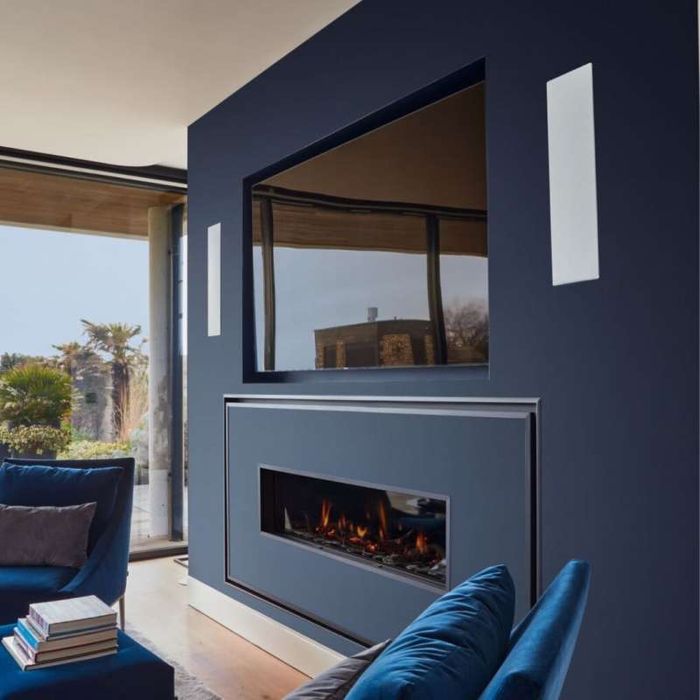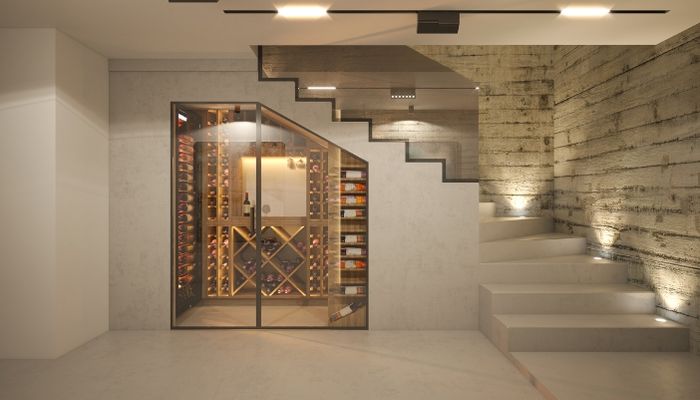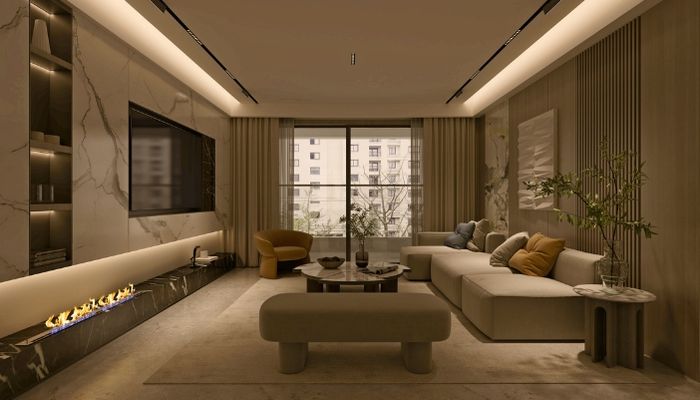
Building a new home is an exciting journey filled with countless decisions. While structural elements and basic utilities naturally take priority in your home building checklist, integrating modern technology and audio-visual solutions during construction can save you significant time and money in the long run. As AV experts with years of experience in southeastern Pennsylvania, we've compiled essential tips to help you create a future-ready home that's both entertaining and smart.
Explore EdgeUp Technology Residential Solutions
Create the perfect home for your family with EdgeUp Technology. Our expertise enables us to design the ideal smart home.
Plan Your Home ProjectWhy Consider AV Integration During Construction?
When designing a house for cost effectiveness, it's crucial to think beyond the basic builder-grade offerings. Pre-planning your home's technology infrastructure during construction can prevent costly retrofits and ensure seamless integration of smart home features. A building consultant can help you navigate these decisions, but here are our expert insights into creating a modern, connected home.
Essential Technology Considerations for Your Home Building Checklist
A typical home building checklist starts with foundational elements like site preparation, foundation work, framing, and rough-ins for basic utilities. During the pre-construction phase, you'll work with your builder on architectural plans, permits, and selecting basic materials. The rough-in phase, which occurs after framing but before drywall, is the critical window for most AV and smart home preparations.
Here's when key decisions typically happen in the building process:
➥ Pre-construction (1-2 months): Basic floor plan, room layouts, and overall technology budget
➥ Foundation & Framing (2-3 months): Decisions about equipment rooms and cable pathways
➥ Pre-drywall/Rough-in (3-4 months): Installation of cables, boxes, and infrastructure
➥ Finishing (4-6 months): Installation of visible components and system programming
The ideal time to start planning your AV and smart home technology is during the architectural design phase, but no later than before drywall installation. This early planning ensures proper power requirements, cable pathways, and equipment spaces are incorporated into your new build. Let's explore the specific technology considerations that should be on your checklist.
Networking Infrastructure: The Foundation of a Smart Home
The best wifi router for large house configurations requires thorough infrastructure planning. While builder-grade homes typically include basic coaxial cables and single CAT5e runs, today's connected homes demand robust networking to support streaming, security, remote work, gaming, and IoT devices.
Essential Infrastructure
Modern networking requires CAT6 or CAT6A cables throughout your home. CAT6 supports 10Gbps speeds up to 55 meters, while CAT6A maintains these speeds for 100 meters. Plan for:
- Dual cable runs to major rooms
- Ceiling drops for wireless access points
- Outdoor runs for security and entertainment
- Dedicated electrical circuits
- Future expansion capability
Professional-Grade Coverage
Builder-grade WiFi solutions with single routers create dead zones and performance issues. A proper mesh network requires:
- Strategically placed access points (30-foot coverage radius)
- Hardwired backhaul connections
- Multi-floor coverage planning
- Outdoor area integration
- Professional equipment selection

Equipment Space and Management
Include a dedicated network closet (minimum 24" x 24" rack) with proper ventilation and accessibility. Your network should support:
- Separate networks for main use, guests, IoT devices, and security
- Quality of Service controls
- Remote management
- Comprehensive security features
Future-Proofing Considerations
Plan for technology evolution through:
- Fiber optic pre-wiring
- Conduit for future cable runs
- Multiple service provider options
- Power and cooling expansion capacity
Common oversights in network planning often lead to costly retrofits. These include inadequate cable runs, poor access point placement, insufficient equipment space, and limited expansion options. Investing in proper infrastructure during construction prevents these issues and ensures your home can adapt to evolving technology needs.
Entertainment Systems and Smart Home Integration
Your home building checklist should carefully consider how entertainment and smart home technology work together. While builder-grade homes typically provide basic audio/visual connections, today's lifestyle demands a more integrated approach. Standard builder packages usually include basic cable outlets, electrical receptacles, and a simple thermostat - but modern homes require comprehensive distributed systems for audio, video, security, and climate control.
Foundational Infrastructure
A central equipment location serves as the heart of your system, requiring dedicated rack space with proper ventilation and power backup. This connects to a structured wiring panel that manages your home's various systems through carefully planned cable pathways and conduits.
Video Distribution and Display
When building an LCD video wall or planning multiple displays, modern entertainment systems require matrix switching for 4K/8K content, gaming optimization, and streaming integration. Wall mounting preparations should include:
- Reinforced backing and proper power placement
- Hidden cable routing with multiple connections
- Future upgrade pathways for emerging technologies
Can Control4 play video from a computer? Yes - through media server integration that supports multiple input sources, gaming consoles, and streaming platforms, all accessible through remote management.

Whole-Home Audio Integration
A whole house stereo system transforms your living experience through strategically placed in-wall/ceiling speakers and outdoor entertainment zones. Modern audio systems support:
- Multi-zone capability with independent source selection
- Voice control integration for hands-free operation
- Weather-resistant outdoor installations with proper grounding

Smart Home Control Systems
Today's automation systems integrate lighting, climate, security, and entertainment into cohesive scenes and routines. Advanced features include:
Core Functions:
- Integrated security with video surveillance and access control
- Climate automation with zone control and energy management
- Motorized shade control for natural light optimization
User Interface:
- Voice and mobile device control with custom interfaces
- Multi-platform support with guest access options
- Scene programming for different activities and times of day

Room-by-Room Planning
Each space requires thoughtful consideration of technology integration. Living areas need strategic display and speaker placement, while bedrooms focus on privacy and sound isolation. Outdoor spaces demand weather-resistant solutions for entertainment and security coverage.
Future-Proofing
Plan for technology evolution through expandable systems, protocol support, and adequate infrastructure for future upgrades. Include additional conduits and power provisions to accommodate emerging technologies.
Lighting Design and Control: Beyond Builder-Grade Basics
Modern lighting transforms your home's atmosphere while improving functionality. Most new builds come with basic ceiling fixtures, toggle switches, and limited placement options that fall short of today's lighting capabilities. Understanding your options during the building process helps create more inviting and functional spaces.
Wall vs. Ceiling Fixtures
While builder-grade homes typically feature basic ceiling-mounted fixtures, wall lighting instead of ceiling light fixture options provide more even light distribution and reduce harsh shadows. These fixtures improve task lighting and facial illumination for video calls while offering easier maintenance access. Pre-construction planning must account for electrical boxes, wall reinforcement, and integration with other lighting layers.

LED and Dimmer Integration
The compatibility between dimmer switches and LED lights is crucial for proper function. Builder-grade switches often cause flickering, limited dimming range, and premature bulb failure. Professional integration includes:
- LED-specific dimmer switches with compatible drivers
- Proper load calculations for optimal performance
- Color temperature control with scene-setting capabilities
Architectural Elements
Crown molding lighting adds sophisticated illumination through integrated LED strips, creating indirect ambient lighting that highlights architectural features. This requires:
- Special molding designs with professional-grade LED strips
- Strategic power supply placement
- Heat dissipation planning
- Control system integration
Smart control systems allow you to control all the lights at once, offering automated scenes, occupancy detection, and mobile access. Installing these systems during construction ensures proper infrastructure with neutral wires at switch locations and central control processors.

Construction Planning
Successful implementation requires:
1. Detailed lighting plans with electrical load calculations
2. Network infrastructure for smart control integration
3. Professional system programming and scene creation
4. User interface configuration and training
Smart Control Integration
Modern homes need the ability to control all the lights at once through smart systems. This goes beyond builder-grade individual switches to include whole-home scene setting, occupancy-based control, time-based automation, mobile device access, and voice control options. The infrastructure to support these systems requires neutral wires at every switch location, robust network connectivity throughout the home, and a central control processor with battery backup - all planned with future expansion in mind. These foundational elements should be installed during construction, as retrofitting them later can be costly and disruptive.
Construction Methods: Making the Right Choice
Understanding design bid build vs design build approaches is crucial for technology integration in your new home. With design-bid-build, you'll follow a sequential process where architects and AV designers create detailed plans before contractors bid - typically taking 3-4 months for design, 1-2 months for bidding, and 8-12 months for construction.
This approach offers precise control over specifications and budgeting but requires coordinating multiple contractors and extensive documentation.
In contrast, design-build offers a unified process under a single contract, typically reducing project time by 20-30% (8-13 months total) and simplifying communication. Design-build enables concurrent technology planning with building design, allowing for more flexible infrastructure planning and real-time problem-solving.
However, either approach requires careful infrastructure planning - you'll need detailed power requirements for each room, cable pathway mapping, equipment space allocation, and cooling/ventilation considerations. Documentation must include system drawings, equipment specifications, cable schedules, and control system programming details. The key is involving experienced AV professionals early in either process. This ensures comprehensive infrastructure planning with accurate budget projections, efficient installation scheduling, and system designs that can accommodate future upgrades. Your timeline should account for pre-wire phases, equipment installation, system programming, testing procedures, and training - all while maintaining flexibility for future technological advances.

Final Thoughts: Building Your Dream Smart Home
Creating your perfect home involves countless decisions, and your home building checklist should include careful consideration of technology integration. From basic infrastructure to advanced automation, these choices will impact your daily life for years to come.
When finishing the interior of your house, remember these key takeaways:
✅ Plan technology infrastructure during initial construction
✅ Consider future expansion needs
✅ Work with experienced AV professionals
✅ Think beyond builder-grade solutions
Professional AV Integration in Pennsylvania
EdgeUP Technology is a leading custom integrator serving Lancaster, PA, and surrounding areas. We specialize in smart home automation, audio-visual solutions, and custom technology integration for both residential and commercial clients. Our team of experts can help you navigate these important decisions during your construction project, ensuring your new home is equipped with the latest in smart home technology and entertainment solutions.
Want to learn more about upgrading your new home's technology? Contact EdgeUP Technology today to discuss your project and discover how we can help create your perfect smart home environment.